The perfect steak:
How to cook the best steak of your life.
Over the last few months, I’ve been on a quest to master the art and science of cooking steak.
Strike that. I’ve been on a quest to cook the perfect steak.
In the process, I’ve culled together pages and pages of notes — from websites, cookbooks, interviews with chefs and my own personal experiences — to put together this, a collection of easy tips that will help you cook the perfect steak.
So let’s get started. Because there’s a-grillin’ to do.
1. Buy from a butcher instead of a grocery store.

The key to any good meal is to use the best ingredients available. When it comes to meat, that means skipping the supermarket and going to a butcher shop instead. There you’ll typically find the highest quality meat available in your area, including grass-fed, hormone-free and ethically-raised options.
2. Try the ribeye steak.
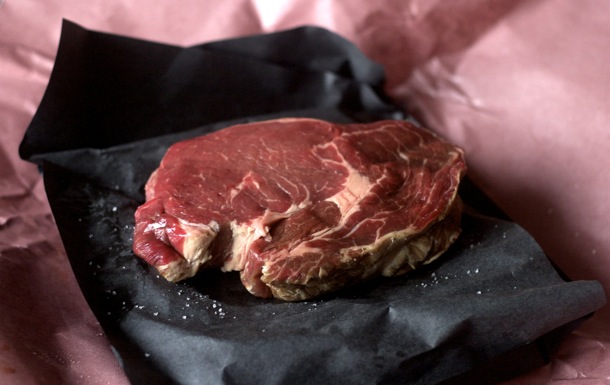
Most people tend to choose very lean cuts of beef for steak. But leaner cuts generally yield drier, blander steaks. A cut with a little extra fat and marbling, on the other hand, will simply taste better, and often with very little preparation.
Nutritionally, a little saturated fat, like that found in beef, is fine. (Beef contains over 40% monounsaturated fat anyway). You just don’t want too much of it, so trim the extra fat after cooking if you’re trying to cut back. Also, instead of going for a leaner cut, you can always just eat a smaller portion of a better tasting one.
So don’t be afraid of the fat; in fact, for a perfect steak with very little marinating, you need a cut with a little fat. Personally, I’ve found the ribeye to be the perfect cut for a great, easy-to-prepare steak.
3. Rub with a clove of fresh garlic.
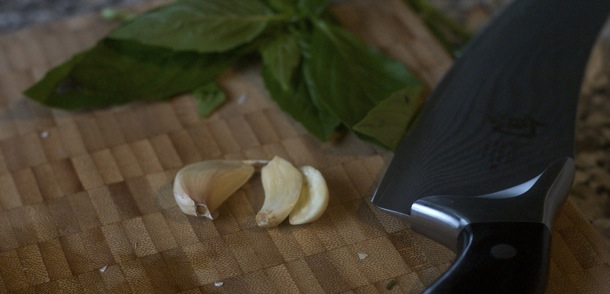
Fresh garlic makes for a quick and delicious steak rub. Slice a clove of garlic in half, and with the cut side, rub the entire steak, sides and edges.
(Bonus tip: to remove the garlic smell from your hands, wash them and rub them against the sides of your stainless steel kitchen sink.)
Don’t stop there, though. There’s more seasoning to be done.
4. Season with plenty of sea salt.
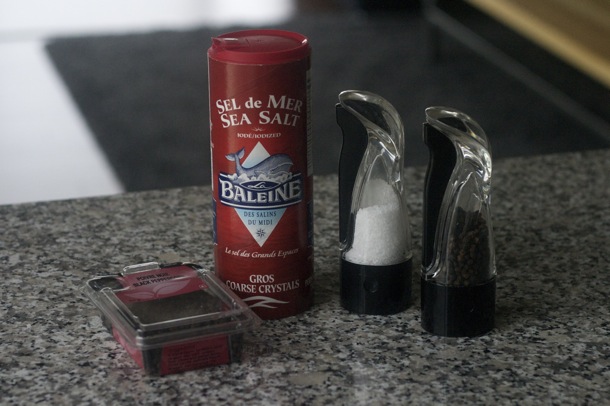
If you don’t have one already, get yourself a salt mill and a pepper mill, and fill them with sea salt crystals and whole peppercorns.
Grind out a generous amount of sea salt and fresh pepper onto both sides of the steak, enough to form a sort of light crust. Use just a little more than you think is necessary.
5. Right before cooking, freeze the steak for 45 minutes.
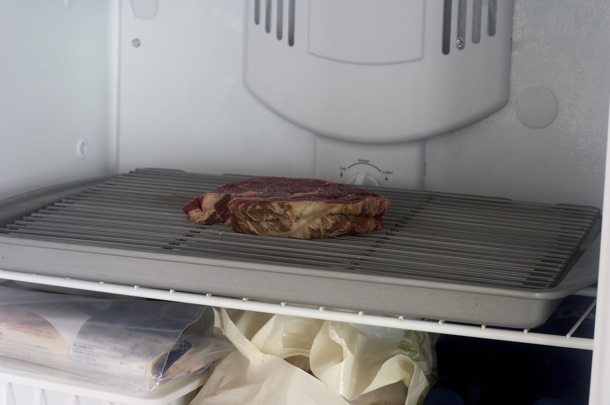
A great steak has a beautiful brown crust, usually achieved in steakhouses with commercial grills and broilers that get much hotter than anything you have at home. A quick hit on that kind of equipment rapidly evaporates surface moisture on the steak and forms the perfectly charred crust.
But with a little trick from Cook’s Illustrated magazine, you can get close. Put your freshly salted steak in the freezer unwrapped on a rack over a paper-towel lined baking sheet for 45 minutes, right before you intend to cook. Freezers are incredibly dry environments (because the moisture in them, well, freezes) and so food placed in a freezer unwrapped dries very quickly. 45 minutes is just enough to dry out the surface without freezing the steak. Any longer than an hour and the steak may start to freeze.
After 45 minutes, take it out and start to grill or pan-sear right away.
(Most chefs recommend letting the steak come to room temperature before grilling or pan frying. The thinking is that if you start with cold meat, the tendency is to burn the outside before cooking the inside to desired doneness. I’ve never found that to be a problem with the “Restaurant Method” I describe below, and in this case, it would ruin the quick-freeze effect.)
6. Use the right cooking fat.
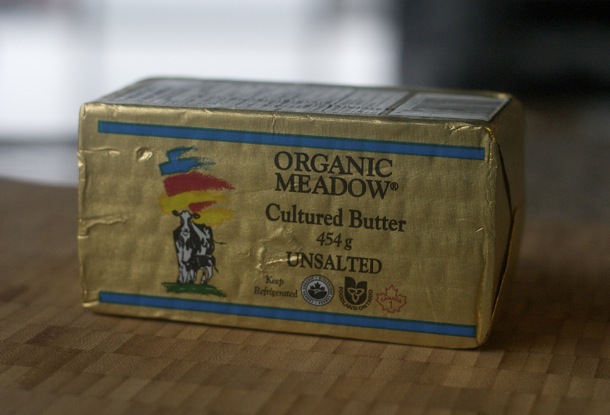
Extra virgin olive oil, while delicious, should not be used to sear steaks, because it’s too delicate and the smoke point is too low. Unless you’re trying to fumigate your kitchen or send smoke signals to distant relatives, use something more stable.
Instead, try cooking with organic butter — higher smoke point, and it’s just as tasty.
7. Use an digital meat thermometer to cook the steak perfectly.

Steakhouses go to extraordinary lengths to cook steaks exactly to their customers’ desired doneness (medium rare, well done, etc.), because overdone and underdone steaks are the #1 complaint they receive. Cook the steak to the right doneness and you’re 90% of the way toward a perfect steak.
A digital meat thermometer (like this one from Amazon) is an easy way to do it precisely. (And, well, we at PN like precision.) Insert it through the edge of the steak, into the center, and make sure it doesn’t touch the fat or the pan itself.
Each level of “doneness” corresponds to an approximate internal temperature of the cooked steak. For example, a medium-rare steak should have an internal temperature of about 130 °F.
Because the interior temperature of the steak will rise even after removed from the pan or grill (see “Let the steak rest” below), remove the steak when it reaches a temperature 5 °F lower than desired doneness. For example, for medium rare, stop cooking at 125 °F. While it’s resting on a plate for 5 minutes afterward, the internal temperature will rise to 130 °F — perfect for medium rare.
Here’s a quick temperature chart for steak:
My preference is to buy a great cut of meat, and cook it to medium rare with a nicely browned crust. But to each their own.
8. Try cooking your steaks using The Restaurant Method.
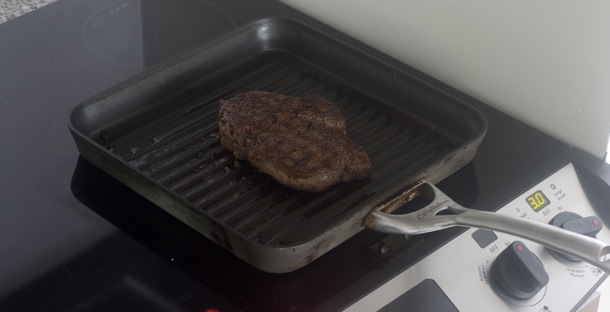
Everyone loves grilling, and of course you can get a great steak that way. But there’s another way — The Restaurant Method — and it’s a dead-simple way to get a perfectly cooked steak, indoors, year round. And that’s something that any steak lover who lives in a true four-season climate can appreciate.
The Restaurant Method is easy:
- Sear the outside of the steak in a pan.
- Roast the inside of the steak in the oven.
Here’s how to do it:
- Preheat the oven to 350 °F.
- Preheat a big pan on medium-high heat. Use a grill pan if you want char lines; otherwise any large pan will do.
- Add a tablespoon of organic butter to the pan; let it melt and swirl it around to coat the pan.
- Sear each side of the steak in the pan for 2 – 5 minutes; peek underneath to know when to flip. You want it brown but not black (i.e., burnt).
- If you like your steak rare to medium rare, you can often stop here. Just check the internal temperature of the steak with your meat thermometer (see above).
- If you like your steak medium to well done, put it in the oven on a small rack over a baking sheet lined with tinfoil to roast for another 5-15 minutes. (Again, with the meat thermometer, you’ll know exactly when to take it out.)
9. Baste with a sprig of rosemary.
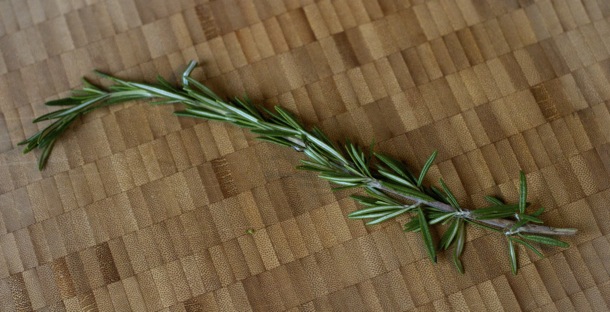
This is a little trick Jamie Oliver teaches, and yet another reason to try cooking your steaks on a pan. With a sprig of fresh rosemary, gather up the juices in the pan. Then, pat the steak all over with the sprig, essentially basting the steak. It’s an incredibly easy way to add flavor.
10. Sear the edges too.
Simple, but not too many people do it. Once both sides of the steak have been seared, use a long pair of tongs to hold the steak and sear the edges too.
11. Serve on a warmed plate.
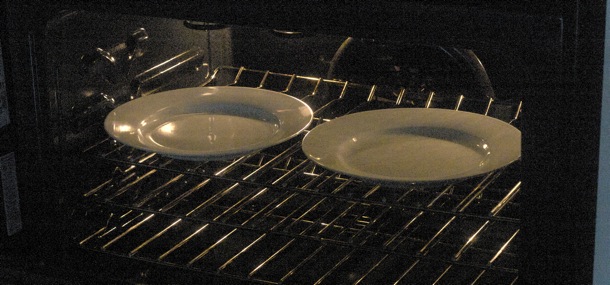
This is one of the easiest things you can do to make any hot meal taste better.
Know how the waiter at your favorite restaurant always gives you that warning, “Careful, this plate is hot”?
That’s because for warm dishes, restaurants often warm the plates too. They understand that serving food at the right temperature is one of the most important factors in your enjoyment of a meal. Put hot food on a room-temperature plate and the plate itself will cool off the food and ruin the effort you put into cooking it just right.
Easy solution? Put your plates in the oven for a few minutes. If you use The Restaurant Method (above) then your oven is already at 350 °F. Just pop your plates in for a minute right at the end.
- Don’t use anything too delicate to withstand the heat, like fine china or (obviously) plastic.
- Don’t leave the plates in for more than a minute, because they’ll be scorching hot.
- Remove them with an oven mitt.
- Remember to warn your guests that the plate is hot — and heed that warning yourself!
(Note: if your dishes are microwave-safe, microwaving them on high for a minute works too.)
12. Let the steaks “rest” for 5 minutes before serving.
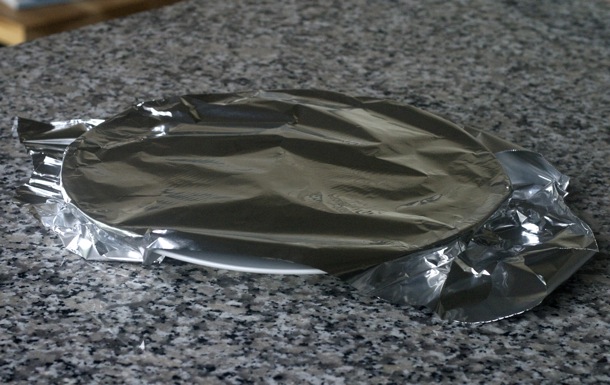
Put the steaks on the warmed plates, cover them with tin foil and let them sit — or “rest,” in chef-speak — for 5 minutes before serving. Why?
1. To let the steak come up to the desired temperature. The exterior of the steak is hotter than the interior at this point. So the outside of the steak will continue to “cook” the inside of the steak for a few minutes, even after you’ve removed the steaks from the pan or grill. That’s where you get the extra 5 °F of internal temperature from.
2. To let the juices redistribute throughout the steak. Under cooking heat, the juices in the steak are driven away from the heat (the exterior of the steak) toward the middle of the steak. By letting it rest, the juices will redistribute move evenly, back toward the edges, instead of pooling in the center. That way, the juices will still be in the meat when you take a bite, instead of leaking out onto the plate as soon as you cut into it.
13. Finish with a little extra virgin olive oil and fresh basil.
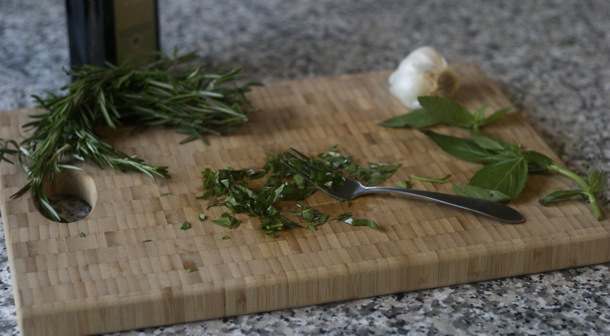
Another Jamie Oliver trick. Pour a little extra virgin olive oil over a wood cutting board. Place a few leaves of fresh basil over the oil and chop them. Then use the back of a fork to grind the basil into the oil.
Then, take your rested steak and lay it on the basil oil. Flip it so both sides of the steak get hit.
Optional: Cut the steak into strips and serve over a bed of organic mixed greens, tossed in a simple lemon vinaigrette for the perfect Anytime (AT) meal.
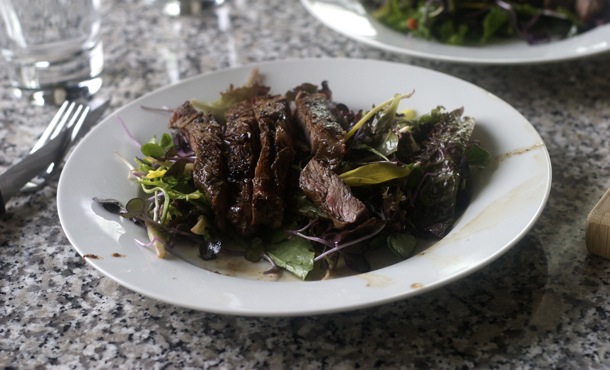
14. Practice.
“Remember that cooking is not an exact science; the results depend on the temperature of ingredients, the cooking equipment you use, and even the climate where you live. The more you practice, the more familiar you will become with how food reacts under certain conditions.”
— Chuck Williams, of Williams-Sonoma fame.
The only way to make a perfect meal is to practice making it again and again. Use the same cut of beef from the same butcher, the same cooking equipment, and keep trying. As long as you’re paying attention, the more you do it, the better the result will be.
Want more cooking help? Try Gourmet Nutrition: The Cookbook for the Fit Food Lover.
If you want to eat well while getting in the best shape of your life, check out our cookbook, Gourmet Nutrition. It’s the only cookbook designed specifically for the fit food lover, with over 120 Precision Nutrition approved recipes, each with detailed instructions and a full-color photo.
Steak marinade jamie oliver
Marinate time: 1 hour on the counter or up to 48 hours in the fridge
1 skirt steak (feeds 2-3 – but I’m not sure how much it weighed)
¼ cup Worcestershire sauce
2 cloves garlic, minced
2 sprigs fresh rosemary leaves, finely chopped
2 fresh (or 1 dried) bay leaf, finely chopped/crushed
Freshly ground black pepper
 Check out the grain on the steak, which is now ready to marinate. The grain goes across the narrow end of the skirt steak. Once it's cooked, you'll be cutting across the grain to tenderize the meat.
Check out the grain on the steak, which is now ready to marinate. The grain goes across the narrow end of the skirt steak. Once it's cooked, you'll be cutting across the grain to tenderize the meat.
 3. At this point, I usually cut the long skirt steak into individual serving size portions (usually 4). Add the steaks to the marinade and make sure they’re coated on both sides. Let it sit in the marinade on the counter for 1 hour or refrigerate for 24-48 hours, flip the steaks over a couple of times to make sure the marinade works its magic evenly.
3. At this point, I usually cut the long skirt steak into individual serving size portions (usually 4). Add the steaks to the marinade and make sure they’re coated on both sides. Let it sit in the marinade on the counter for 1 hour or refrigerate for 24-48 hours, flip the steaks over a couple of times to make sure the marinade works its magic evenly.
Simply Delicious Steak Marinade
This recipe was uploaded
Ingredients
- 2 Baseball cut sirloin steaks (or any other tender cut steak)
- 2 tsp Kosher salt
- 4 Whole black peppercorns
- 1 Small green onion
- 1 Clove of garlic
- 1 tsp dried Marjoram
- 1 tsp dired Savory
- 2 tsp fresh Rosemary
- 1 1/2 tsp Seasoning Salt (I like Back Eddy's)
- Olive Oil
- Balsamic Vinegar
2. Sprinkle all ingrediants evenly over steaks, except oil and vinegar. Rub in.
3. Drizzle just a touch of oil, so that there is no more than a very thin layer on the bottom of the container or bag. (Too much oil will take some flavor away from the steak). Then pour in a generous ammount of balsamic vinegar (about 1 1/2 times the ammount of oil).
4. Place in the fridge. Shake container or smush bag every couple of hours. Marinate for as little as 2 hours or as much as 24 (It's up to you and your alotted time).
Simply Delicious Steak Marinade
Are you sure you want to delete this recipe?
This recipe was uploaded by
2. Sprinkle all ingrediants evenly over steaks, except oil and vinegar. Rub in.
3. Drizzle just a touch of oil, so that there is no more than a very thin layer on the bottom of the container or bag. (Too much oil will take some flavor away from the steak). Then pour in a generous ammount of balsamic vinegar (about 1 1/2 times the ammount of oil).
4. Place in the fridge. Shake container or smush bag every couple of hours. Marinate for as little as 2 hours or as much as 24 (It's up to you and your alotted time).
Rosemary, Garlic and Lemon Marinade
Ingredients
- 2 good handfuls fresh rosemary, pounded
- 6 cloves garlic, crushed
- 10 lugs (10 tablespoons) olive oil
- 3 lemons, halved, juiced and skin squashed
- Freshly ground black pepper
Directions
Mix everything together and massage on to your chosen meat. Leave the meat in the marinade until your ready to cook it;
Categories:
Recipe of the Day
Get an editor-picked recipe delivered to your inbox daily. Privacy Policy
9 Marinades for Grilled Steak
All steaks can benefit from a good marinade, but when grilling less marbled or chewier cuts, like flank or skirt, a marinade can take your meat to another level.
All steaks can benefit from a good marinade, but when grilling less marbled or chewier cuts, like flank or skirt, a marinade can take your meat to another level. Depending on the ingredients, it might help tenderize it to boot.
1. Balsamic. A basic balsamic vinaigrette is a no-think marinade that is always a good choice for steak, especially when you serve the meat in a salad.
2. Lemon-garlic. For an even simpler Mediterranean-style marinade, toss the steak with herbs, garlic and olive oil, then top with lemon slices for subtle flavor.
3. Soy sauce. For a grilled steak you could add to a number of different Asian-style dishes, toss the meat with soy sauce, sesame oil and sugar.
4. Korean-style. Koreans love bulgogi, which is usually made with short ribs, but there’s no reason you can’t use that sweet-savory marinade on steak.
5. Southeast Asian-style. For a steak that will hit a lot of spots on the tongue, bathe it in a blend of herbs, garlic, chile sauce and fish sauce.
6. Mojo. Think of this citrusy, cumin-spiced sauce as vinaigrette, Cuban-style. It works beautifully as a marinade for steak because the sugars in the citrus juice caramelize on the grill. Or keep the Latin marinade even simpler and just use tequila, lime juice and garlic.
7. Chipotle. The adobo sauce that comes in a can of chipotles? It’s a brilliant, richly flavored marinade for steak. Just blend it with garlic, orange juice and olive oil before you rub it on your meat.
8. Papaya skins. If tenderizing steak is your goal, use this trick they use in many parts of the world: Rub your steak with a simple marinade and then cover it with papaya skins, which contain an enzyme that breaks down tough meat fibers.
9. Cola. Cola (yep, the soda) is another meat tenderizer; plus its sugars caramelize nicely on the grill.
Kristin Donnelly is a former Food & Wine editor and author of the forthcoming The Modern Potluck (Clarkson Potter, 2016). She is also the cofounder of Stewart & Claire, an all-natural line of lip balms made in Brooklyn.
Steak Marinade
Recipe by LuuvBunny
people discussing
Top Review by
Top Review by
people discussing
Steak Marinade
SERVES:
Ingredients Nutrition
- 1 tablespoon olive oil
- 1 garlic clove, minced
- 1 tablespoon Worcestershire sauce
- 1 tablespoon balsamic vinegar or 1 tablespoon white vinegar
- 1 teaspoon yellow mustard
- 1 tablespoon soy sauce
- pepper
Directions
- Mix all ingredients together and place steaks into freezer bag with marinade, preferably overnight.
- The original recipe used balsamic vinegar.Seems I never had that on hand so I just used white and listed that in the recipe, but balsamic is definitely better.
get the genius kitchen app.
Watch on your iPhone, iPad, Apple TV, Android, Roku, or Fire TV.
get the genius kitchen app.
Watch on your iPhone, iPad, Apple TV, Android, Roku, or Fire TV.
Join the Conversation
- all
- reviews
- tweaks
- q & a
Attach Photo
Would you like to attach a photo to your submission?
- Browse
- Cancel
Attach Photo
The image has been attached to your submission.
Report this post?
Are you sure you want to report this post for review?
- Yes, report it.
- Oops! Cancel!
You must be logged in to interact with the activity feed.
- Log in now
- Cancel
Missing Input
Please enter a rating or review before submitting.
Missing Input
Please enter a reply before submitting.
Please enter your before submitting.
Your reply has been submitted for moderation.
There was an error processing your submission. Please refresh and try again!
Nutrition Info
Serving Size: 1 (24 g)
Servings Per Recipe: 3
Amt. Per Serving % Daily Value Calories 55.1 Calories from Fat 41 75% Total Fat 4.6 g 7% Saturated Fat 0.6 g 3% Cholesterol 0 mg 0% Sodium 411.1 mg 17% Total Carbohydrate 2.8 g 0% Dietary Fiber 0.1 g 0% Sugars 1.5 g 5% Protein 0.8 g 1%
Flank Steak with Herbed Salsa
Jamie Oliver likes to chop all the salsa ingredients together on a large cutting board so the tomatoes, garlic, jalapeño and herbs get well combined. He even seasons the salsa and adds a splash of olive oil on the board. Slideshow: More Salsa Recipes
Ingredients
- 2 medium tomatoes, finely chopped
- 4 scallions, finely chopped
- 1 cup cilantro leaves, finely chopped
- 1/2 cup mint leaves, finely chopped
- 1 large jalapeño, seeded and minced
- 1 garlic clove, minced
- Juice of 1 lemon
- Salt and freshly ground pepper
- One 1-pound flank steak
- 2 teaspoons extra-virgin olive oil
How to Make It
Light a grill or heat a grill pan. In a bowl, combine the tomatoes with the scallions, cilantro, mint, jalapeño, garlic and lemon juice. Season the salsa with salt and pepper.
Rub the steak with the oil and season with salt and pepper. Grill over high heat until nicely charred outside and medium-rare, 3 minutes per side. Transfer the steak to a carving board; let rest for 5 minutes. Thinly slice the steak across the grain and serve with the salsa.
How to Marinate Steak Without a Recipe
Photo by Chelsea Kyle
Master this basic marinating technique and you'll be grilling crowd-pleasing steaks all summer long.
For the grill, I always choose a thin, quick-cooking steak—I'm talking skirt, hanger, or flank steak; tri-tip, short ribs, faux hanger (aka bavette, sirloin tip, or flap meat), or entraña steak. These are all cut from large, strong, active muscles, which makes them more flavorful and great for serving a crowd. But those strong muscles are also naturally tougher. Which is why these steaks require a marinade.
Making a steak marinade is a lot like making a salad dressing—you can customize it depending on your mood, your menu, or whatever happens to be in your pantry. But unlike salad dressing, you want the flavors in your marinade to be extra strong—strong enough to infuse the meat with flavor that will linger long after the marinade is discarded.
Every steak marinade needs four elements—oil, acid, flavoring, and salt. Once you understand the basic ratio and timeline of how to marinate steak, you'll never need to look at another recipe again.
Let's dig in: here's how to marinate steak without a recipe:
1. Start your marinade with oil
Your marinade should be at least 1/2 oil. The oil helps emulsify the marinade into a thick sauce that coats the meat. It's also a flavor-carrier. And having a coating of an oil-based sauce on your steak before you grill it will help it cook better and more evenly.
You'll need 1/2 cup of marinade per pound of meat you're grilling, and you want that marinade to be at least half oil, so for two pounds of steak, start with 1/2 cup of oil. If you don't want to taste the oil, go for a neutral oil like grapeseed or canola. If you're open to a stronger flavor, try olive oil or sesame oil or even an infused oil. You can mix together a couple oils or stick with just one. And of course you can add more later if needed once you get all the other elements in play.
2. Add acid, but not too much
Acid helps tenderize tough connective tissues—which my favorite steaks have plenty of—but too much acid will actually cook and toughen the meat, turning it weird and chalky. To prevent this from happening, use equal parts or less acid to oil.
You can always add more acid later, but you can't take it away. So though you can add up to as much acid as oil, I like to start with less, just to be safe. For two pounds of steak I usually start by whisking together 1/4 cup of acid and 1/2 cup of oil. What kind of acid you use depends on how you want it to taste—you could use a fresh fruit juice such as lemon juice, orange juice, or pineapple juice, or you could use any kind of vinegar such as balsamic, apple cider, or rice vinegar. Your acid could also come in the form of wine, beer, buttermilk, yogurt, or even puréed onions and garlic. I love a classic combo of olive oil and balsamic on a juicy hanger steak.
3. Mix In Some Flavorings
The flavoring elements are simply that—flavor for the surface of your steak. So have fun and add whatever you think tastes good. Raid your condiment collection as well as your spice cupboard and herb garden. Try Worcestershire sauce or mustard, some miso or chili paste, sliced garlic or shallots or grated or pressed garlic, roughly chopped fresh herbs or herb sprigs (or a smooth purée of fresh herbs), fresh or dried chiles, whole or ground spices, ketchup or sriracha, or grated or sliced fresh ginger or citrus zest. (I add Dijon mustard, garlic, rosemary, thyme, and pepper to my balsamic marinade.)

Putting the final touches on my balsamic marinade for hanger steak.
Photo by Chelsea Kyle, Food Styling by Anna Stockwell
4. Get Sweet and Salty
To balance out the flavor, just as you would a salad dressing, you need to also add something sweet and something salty to your marinade. The salt is essential as a tenderizer and moisture retainer for the meat, but it doesn't have to come from actual salt—you can also use a salty liquid such as soy sauce or fish sauce. Sugar is not as essential, but helps balance out the flavor. If one of your acids or flavorings is already naturally sweet, you can skip adding a sweetener entirely, otherwise try whisking in a pinch of brown sugar, a squirt of honey, or a splash of maple syrup. (Too much sugar will make the steak burn when you toss it on the grill, so go light with the sweetener—the marinade is not supposed to taste sweet, just well-rounded.)
Speaking of taste: This is the moment when you want to taste your marinade. Adjust your salt, sugar, flavoring, acid, and oil levels as needed. If you find you've made more than your needed amount of marinade, set the rest aside to use another time or turn it into a sauce or dressing.
5. Marinate for at least one hour, and up to 12
Pour your marinade over your steak and toss to coat. You want to have as much meat surface as possible in contact with the marinade, and the easiest way to do this is in a resealable plastic bag, where you can seal it up tight so the marinade is encircling the meat entirely. If you're not into plastic bags, use a glass or ceramic baking dish or wide shallow bowl and flip the meat every now and then. If you plan to cook the meat within one or two hours, leave it out on the counter to marinate; otherwise put it in the fridge. Just remember to remove the meat about an hour before grilling so it has a chance to come to room temperature.
Thin cuts of steak shouldn't marinate for more than 10 or 12 hours, so this is not so much of an overnight thing—more of a marinade it in the morning, grill it at night game. The shortest amount of time you can get away with is one hour. Any shorter and the marinade won't have a chance to work its magic.
6. Pat it down, then grill
When your grill is ready for cooking, remove the steak from the marinade and give it a good pat down with paper towels. Make sure no bulky flavorings like slices of jalapeño are stuck to the meat—they'll just burn on the grill.
Your cook time will depend on the heat of your grill and the cut of steak you're using, but generally speaking all thin cuts fare well cooked over high heat. They won't take long, so have your thermometer and tongs at the ready and keep flipping them over high heat and checking the internal temperature until your steak reaches your desired doneness. Aim to pull it off the grill at 120–125°F for medium-rare, or 130–135°F for medium. If you don't have a thermometer, simply slice into the steak a bit to have a peek at the color in the center to know if it's done to your liking.

Now that's a good summer supper.
Photo by Chelsea Kyle, Food Styling by Anna Stockwell
7. Don't forget to rest, and slice against the grain
Give your grilled steak five minutes to rest—you don't need longer for thin cuts like these—and then slice it against the grain and serve.
Our Newest Recipes
Pappardelle with Slow-Cooked Brisket
Ricotta Cheesecake with Almond Praline
Simple Vanilla Jam Drops
Sweet and Buttery Loaf
Cinnamon Toast Bites
Epicurious Links
Connect with Epicurious
Helpful Links
Food Innovation Group
Condé Nast
Condé Nast Websites
Condé Nast Services
Legal Notice
© 2017 Condé Nast. All rights reserved
Use of this site constitutes acceptance of our User Agreement (effective 1/2/2014) and Privacy Policy (effective 1/2/2014)
The material on this site may not be reproduced, distributed, transmitted, cached or otherwise used, except with the prior written permission of Condé Nast.
Beef Steak Marinade
This is a simple but magical beef steak marinade that truly tenderises and infuses the steak with flavour, transforming good value steaks into “wow!”. It injects enough flavour that the steak can be eaten plain without sauce or even butter but does not overpower the flavour of the beef, which would be a travesty!
Use this beef steak marinade when you aren’t splurging on prime-grade steaks. It works great on any cut of beef suitable for grilling!
I got a hankering for a big, juicy steak.
As it happened, last Friday was abnormally warm considering it’s the middle of winter – 25C/ 80F. Perfect grilling weather. So I tottered into my local village (breaking in new heels), planning to go all out and get a thick top-of-the-line 45 days dry aged Rib Eye. Tied Dozer up outside the butcher and went inside.
As I eyed off the steaks, I heard a pathetic wail from outside. Yes, Dozer. Wailing because I’m inside with all the juicy meat and he’s tethered to a pole.
One little howl and he draws a crowd like moths to a flame. Patting and consoling, cooing to him.
But it worked. Because I paused. And realised that it would be inevitable that I would cave and give him some steak because he’s been somewhat depressed lately, being sidelined due to injuries.
And there was no way I was sharing a prime grade rib eye with him.
So I got a normal T-Bone. And decided to doll it up with a marinade. 😉
The Serious Stuff About Steaks & Marinades
Now that I’ve had my moment of Dozer fawning, I can get down to business!
Fact: Steaks are like wine – the more you spend, the better they are. Juicier, more flavour, more tender, no random bits of sinew throughout.
Fact: Steak Marinades can make steaks more tender and inject flavour into them. So you can seriously transform an every day beef steak into something that tastes as good as a premium cut (in my humble opinion).
Fact: It’s easy to make marinades that infuse flavour into meat. But it’s harder to make marinades that enhance without adding too much flavour into the steak. You want the steak to taste mainly of (gasp, shock horror!) BEEF. Not overwhelmed by marinade flavour.
Fact: Many beef steak marinades will flavour but won’t actually tenderise meat. In order to tenderise beef steak, you need either a tenderising ingredient (typically something acidic) and/or salty liquid to act as a brine to retain moisture. I use both. Soy sauce as the brine element and balsamic vinegar as the tenderiser. So there’s a double effect – tenderising PLUS keeping the beef plump and juicy. 🙂
I promise you, this Beef Steak Marinade makes the beef so juicy and adds enough flavour that you do not need a sauce or mustard on the side.
But because steaks are a bit of a treat in my world, I couldn’t resist going all out and making a little herb butter to accompany the steak.
Oh – and baked potatoes. And grilled corn. (And a few sad stalks of asparagus I dug out from the bottom of the fridge).
Save this Beef Steak Marinade to your GRILLING Pinterest Board!
- 2 large steaks (I used 2 x 400g/14oz t bone steaks) (Note 1)
- 1 tsp Dijon mustard
- ½ tsp minced garlic (1 large garlic clove)
- ½ tsp onion powder (or sub with garlic powder)
- 1 tbsp soy sauce (Note 2)
- 1 tbsp oil (I use olive oil, but any oil is fine)
- 1 tbsp Worcestershire sauce
- 1 tbsp balsamic vinegar
- Black pepper
- Mix together mustard, garlic and onion powder. Then mix in remaining ingredients.
- Place beef in a ziplock bag with Marinade and marinade overnight (12 - 24 hours).
- Remove from the fridge 1 hour before cooking to bring to room temperature. Shake off excess marinade.
- Heat skillet (or BBQ) on high heat until is really hot - you should see wisps of smoke. Add oil - it will heat almost instantly. Add steaks and cook the first side for 2 minutes, then turn and cook the other side for 1½ minutes (for very medium rare). (Note 3)
- Remove from skillet onto a WARM plate, cover loosely with foil and set aside for 5 minutes.
- Serve with baked potatoes and corn! I couldn't resist herb butter - see recipe in notes.
300g/10oz exc bone), excluding herb butter.
Marinated Steak nutrition per serving.
LIFE OF DOZER – We shared one steak. The homeless man at the dog park got the other. He really enjoyed it too!?
OMG this marinade is to die for – used T bones and the flavour was incredible – we had it with onion rings – retro I know . and salad – another great recipe thank you Nagi and love to Dozer
That’s great to hear Kym, thanks for sharing your feedback! N x ❤️
which one do you prefer?beef or porkchop.
Don’t make me choose! 😂
I enjoyed your blog. A real sense of transparency and realism to your writing. Thank you. I hardly ever subscribe but I really like the way you came across.
Thanks for the compliment! I’m very flattered 🙂 N xx
This marinade is fantastic . I put my New York Strip steaks in the marinade 24 hours before we grilled and flavor was wonderful. Thank you for sharing.
That’s fantastic to hear Becky! Thank you for letting me know – N xx
I’m hoping that’s a five star rating! 😉
Hi Nagi! Loved this one. The herb butter really takes it to the next level and should be compulsory… Did it with supermarket porterhouse and it really transformed it into something fantastic.
WHOOT!! PS I am with you on that butter…. 🙂 N xx
Would this work for thick porkchops?
Catherine Hall says
As a 60 year old who has never prepared her steak other than with some oil and a bit of seasoning before slapping it in the pan to cook, I can only say my eyes have been opened…. not to mention my tastebuds. This marinade is sensational. My new favourite taste!! Thank you 😊😊😊
Whoot! 🙌🏻 So happy to hear that Catherine, thanks for letting me know! N xx
What can I sub for soy sauce? I can’t have soy/MSG. Would coco aminos work?
Can you use tamari? 🙂
SHARON SLOANE says
She is not to use tamari, it has to much flavor and no dark soy either.Hope this helps
Moira Alfers says
Had to double the amount of sauce, and add an extra steak…I have 3 dogs! ?
Your LUCKY DOGS.
Tried this last night and loved it. Hubby said this recipe is a keeper we no longer have to buy the marinade packet from the store.
AWESOME. I’m so glad to hear that Lira, thanks for letting me know! N xx
Just tried this recipe for “brunch”.. really gooooood! the taste was just perfect. not too overwhelming! I added a pinch of cayenne powder though, I LOVE IT! Will definitely do this again! Thanks for the recipe!
Awesome! I’m so glad you enjoyed it Nicole! N x
Leave a Reply Cancel reply
Find a recipe!
Hi, I’m Nagi!
I believe you can make great food with everyday ingredients even if you’re short on time and cost conscious. You just need to cook clever and get creative! ♥
Never miss a recipe!
Join my free email list and receive TWO free cookbooks!









Hi, I’m Nagi!
I believe you can make great food with everyday ingredients even if you’re short on time and cost conscious. You just need to cook clever and get creative! ♥ Read More…
Steak Marinade and Rub Recipes
These zesty concoctions tenderize meat while infusing it with flavor. Place the steak and the marinade in a shallow bowl and let sit for 30 minutes or up to overnight in the refrigerator.
If you don't have rosemary on hand, fresh thyme or marjoram will work just as well.
Balsamic-Soy Marinade
Give steak a salty-sweet kick with an Asian-inspired marinade.
All-Purpose Steak Rub
Want to add a kick to steak and simultaneously seal in succulent juices? Use a rub, pressing gently to help it adhere. Apply just before cooking.
All-Purpose Steak Rub
This rub can be kept for up to 2 weeks in an airtight container at room temperature.
Lemon, Thyme, and Pepper Rub
To add more heat to his citrusy rub, use crushed black pepper (sometimes called butcher’s grind) in place of ground pepper.
Комментариев нет:
Отправить комментарий